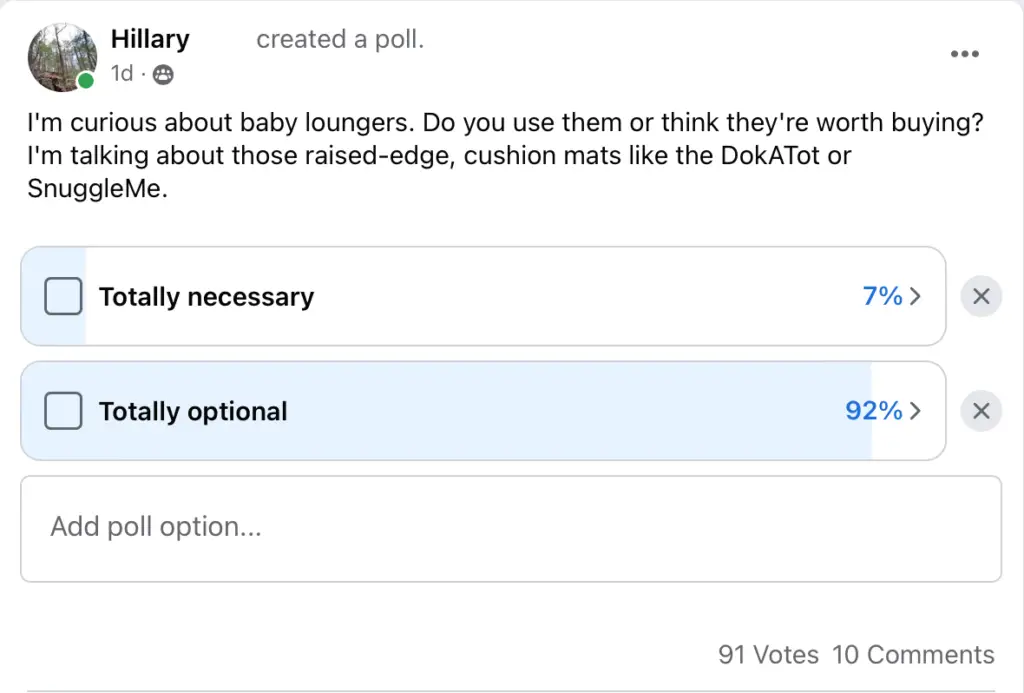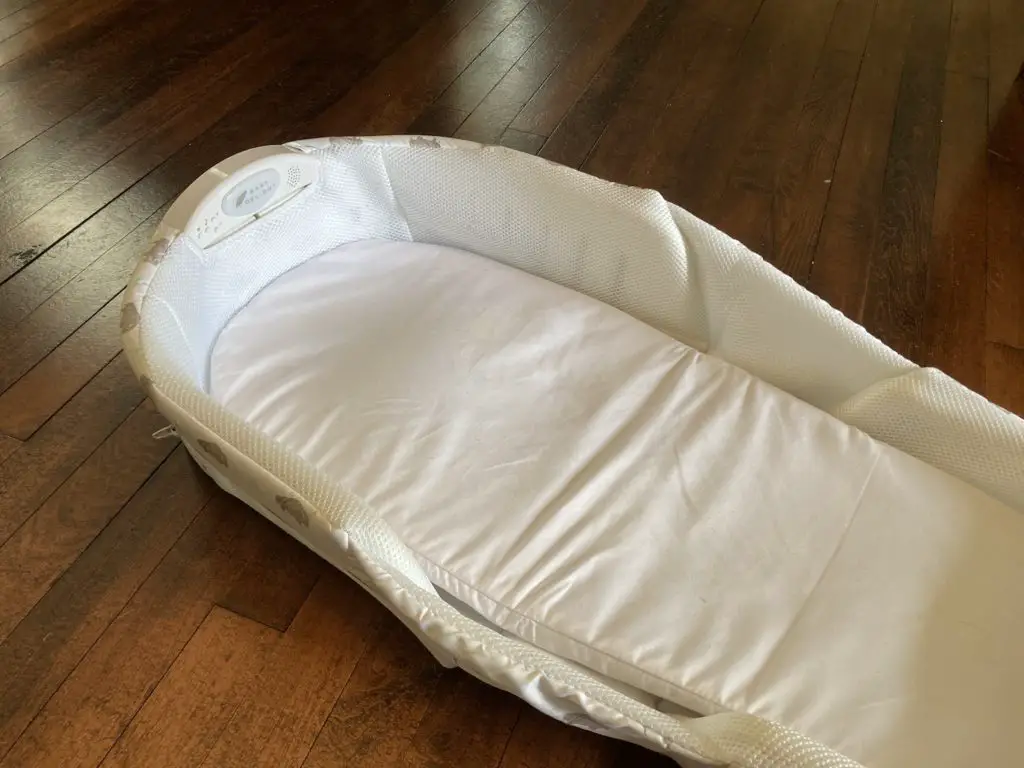Of all the presents I received at my baby shower, I was most confused about this one, oval-shaped mat. Did I really need a baby lounger? I already had a pack and play, a baby carrier, a bouncer, and what felt like a dozen other gadgets.
As it turns out, I didn’t need it. We tried it a few times with each kiddo, but they just preferred being held, carried, or laying somewhere that rocked/bounced. The lounger is now collecting dust on a shelf in the basement.
It can be hard to cut through all the marketing we get as anxious, unaware parents-to-be. However, I’m just one person, and I knew my experiences might not represent those of everyone else. So I asked nearly 100 other moms what they thought– are baby loungers an essential baby product? Here’s what they said.
(And if you’d like to read about ALL the baby products 6,000 moms did (and didn’t) recommend over my six months of research, you can read my essentials-only baby registry checklist article here!)
Are Baby Loungers Worth Buying?
As a general rule, new parents don’t need baby loungers and shouldn’t consider them worth buying. 92% of surveyed moms said they were merely an optional baby purchase. There are better products which offer a safe place for your newborn that cost less and have additional functionality.

The comments section had tons of useful anecdotes, too. It was interesting to me that even many of the moms who DID use a baby lounger still considered them non-essential. One mom said she used hers “every day for the first year” but still said it was just an optional purchase. Another said it was so helpful, but she made her own by rolling up a blanket and covering it with a swaddle to make the indented shape.
Why did so many moms say baby loungers weren’t necessary? The reasons varied, but high costs, limited functionality, and concerns about safe sleep were all mentioned multiple times.
What’s the Point of a Baby Lounger?
Baby loungers are designed to be a comfortable spot to lay your baby down when you need two hands free, and no one else is available to hold him or her. They can also be used as a changing pad or a spot for “tummy time.”
It might surprise some parents-to-be to learn how essential “put down” spots become once your baby arrives. I know I didn’t think much about it during my first pregnancy! However, you’ll soon realize the problem once you’re alone with your baby for the first time and need to go to the bathroom.
Though this is the problem baby loungers were designed to solve, there are plenty of other products which can do the same job. Some of them, like a pack and play, are already on most new parents’ baby registries. That means buying one can contribute more to the baby gear clutter you’re likely to be swimming in by your child’s first birthday.
Reasons Baby Loungers Aren’t Necessary
Your baby can’t sleep in a baby lounger
According to the CDC, the safest place for babies to sleep is on their backs on a “firm, flat sleep surface, such as a mattress in a safety-approved crib.” A baby lounger doesn’t meet any of those definitions, so if your child does happen to fall asleep in one, you’re supposed to move them. (Good luck keeping them sleeping through that transition.)
Supervision is required
Parents often want a baby lounger so they have somewhere safe they can place their baby for a moment. Sometimes, you just need to run to the bathroom, grab a snack, or go upstairs– and you don’t want to hold your baby while doing it.
But though this is a common suggestion, it’s not recommended. Companies producing baby loungers specifically state on their websites that their products are only to be used with supervision. You never know when your baby will roll over for the first time, (I have a friend who’s son once rolled at two weeks old!) so you need to keep an eye out. The soft sides of many baby loungers could cause suffocation if a baby rolled face-down onto them.
They’re only useful for a few months
Most babies learn to roll over by 4 months of age. After that point, the slight, soft edges around baby lounger become nothing more than a challenge for your little one to flip over. Though many baby loungers may claim to be for 0-6 or 0-9 month olds, most babies are far more interested in exploring their environment and stretching their muscles than laying on their back or staying on a mat.
Baby loungers are expensive
Popular options like the DokATot or the SnuggleMe branded baby loungers have price tags that start around $75 and go up to over $200. All that for a weirdly-shaped pillow you put on the ground!
Though I commonly recommend buying used baby gear, some parents might be uncomfortable buying what amounts to a mini mattress used.

Alternatives to a Baby Lounger
Even if you decide not to get a baby lounger, the problem remains – where can you safely put your baby? Here are a few common alternatives which more moms DO recommend.
Baby carrier
If you’re primarily looking for a way to soothe or comfort your newborn hands-free, you’ll want a baby carrier. Though it does mean your baby stays attached to you, a majority of moms consider a baby carrier an essential baby purchase. (I talk more about baby carriers in my article Do You Need A Baby Carrier?)
Baby swing
I’ve also polled hundreds of parents about their thoughts on whether you need a baby swing in my article on the topic. If your baby loves the movement of being in your arms, but you REALLY need both hands and no tag-along, a swing is a great choice. They do take up more space than most other baby products, but usually come with a number of settings and motion levels. Some, like this Graco model we have, even have a detachable seat so you could use it as both a bouncer and a swing.
Baby bouncer
Baby bouncers are portable like a baby lounger, but also offer some vibrating and/or bouncing sensations, an inclined position for a better view, and clips to keep baby firmly in place. Some have a curved base so they rock back and forth, too. You can read my article on whether or not you need a baby bouncer here, if you’re curious about the average mom’s opinion on this alternative.
Pack and Play
This is the gold standard for baby gear, in my and many other mom’s opinions. More of the moms in my survey mentioned pack and plays as a better alternative to a baby lounger than anything else. I also wrote a whole article devoted to whether you need a pack ‘n play which includes a survey of nearly 800 moms.
Why? They’re usable for longer than a lounger, for starters. (Case in point– my three year old still plays in hers!) Many pack and plays like this one also have top attachments that can function like a bassinet and a changing table. We used this one for both kids, and it’s still going strong.
One of the often noted benefits of a baby lounger is a familiar spot for baby when traveling or vacationing. Of course, a pack and play does the same thing while also acting like a portable crib, thus saving packing space in your luggage or car.
Most importantly, a baby CAN safely sleep in a pack and play, so you won’t have to move them if they get drowsy.
Bumbo (or similar)
If you have a somewhat older baby, they might enjoy sitting in a Bumbo. (But don’t actually buy it from Amazon before checking your local children’s consignment store– they usually have at least two or three!) These hard plastic seats offer a supported, upright position for babies strong enough to hold their own heads up, but unable to sit independently. That means they’re useful for a few months, usually between 6-10 months old or so.
As a bonus, Bumbos are the only alternative on this list that can also be used as a high chair or feeding station, especially while traveling.
Blanket on the ground
Depending on your baby’s age and the circumstances, a simple blanket thrown on the ground can work as a place to put your baby in a pinch. Of course, you use caution with this strategy if there are any potential hazards around like pets, overenthusiastic toddlers or older children, unsafe surfaces.
The Academy of American Pediatrics uses the term container baby syndrome to describe describe “issues seen in infants who spend too much time in devices (or “containers”) that inhibit movement”. These issues can include plagiocephaly, decreased strength, and delayed motor milestones. Time on the floor can be great! The more time babies can spend in a naturally responsive environment where they can strengthen their muscles, the better.
You made it to the bottom? Wow! You must have liked this article. If you want to read more posts about parenthood and saving money while raising a family, you should sign up for the weekly newsletter below to see all my latest posts.
